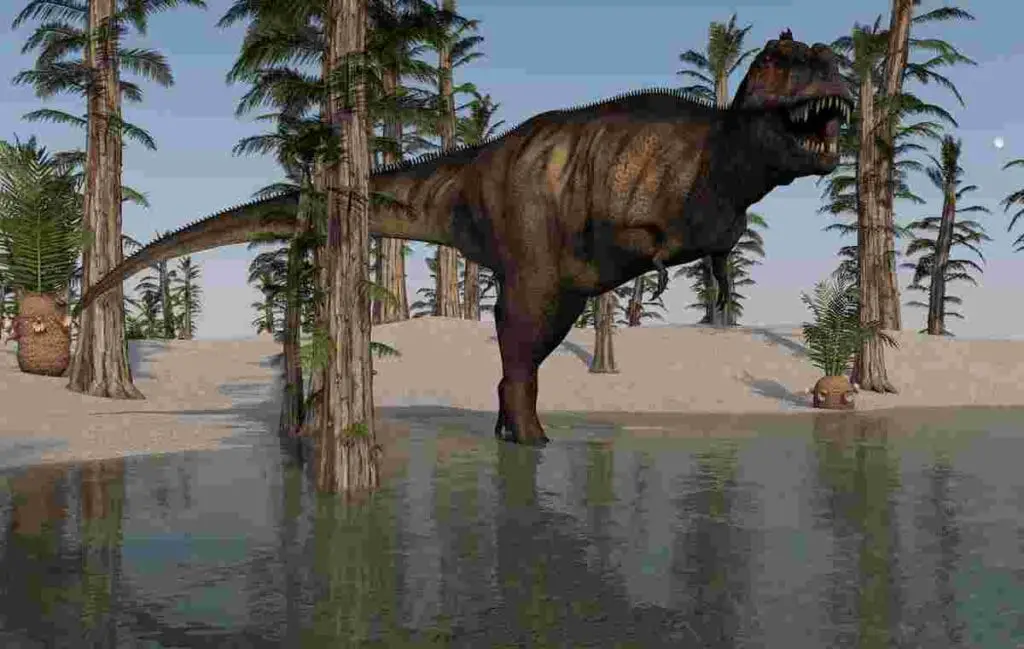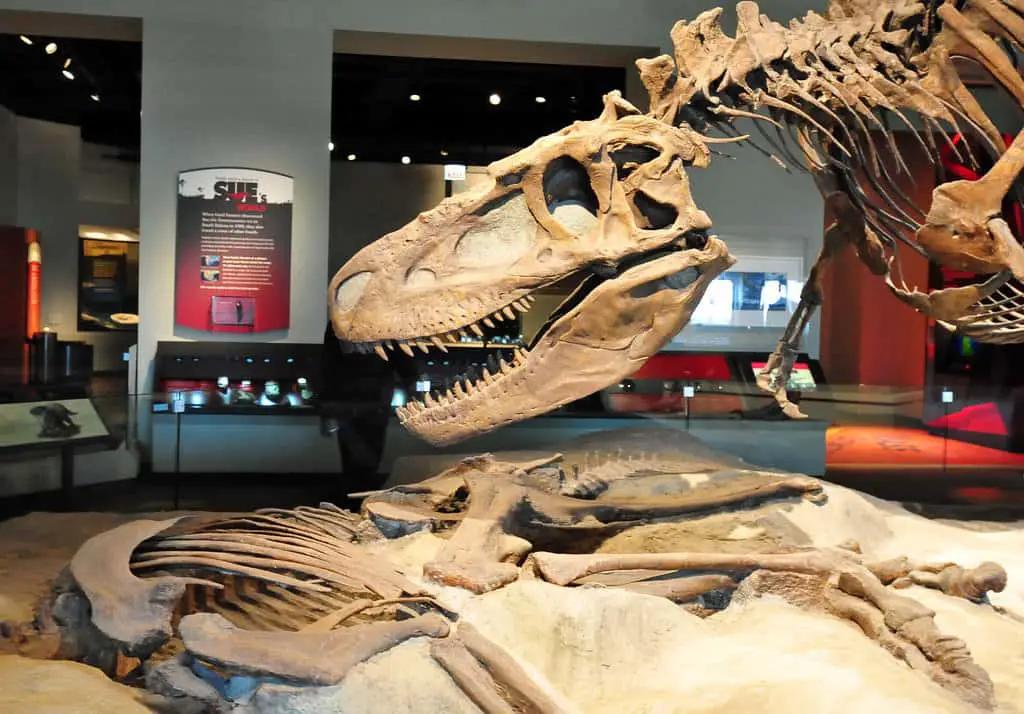Could T-Rex Swim? Dinosaur Swimmers Like Spinosaurus Could Swim
The Tyrannosaurus rex is known to be the king of the dinosaurs — at least above water. The underwater title goes to the Spinosaurus, which is more capable of hunting aquatic than any other dinosaur species. However, since the T-rex lived in marshy wetlands and coastal plains near bodies of water, it has been speculated for years by different schools of thought that they might have hunted in and around water for their prey. This makes me wonder, could T. rex swim?

Can A Tyrannosaurus Rex Swim?
So, can a Tyrannosaurus Rex Swim? Yes, they can swim in water but not with agility enough to catch fish or prey that dived underwater. The reason is that they were not designed for hunting in water for prey effectively in the first place. Their apex predator features are more suitable above water.
The Tyrannosaurus Rex – a pivotal carnivore dinosaur species of the Jurassic Period, arouses curiosity among scientists and paleontologists about its swimming abilities.
The main area of focus is the creature’s anatomy, in particular, its legs. Insight derived from a comprehensive study of the dinosaur’s physiology can provide answers about its adaptability and survival competencies, including its potential to swim.
Table of Contents
Researchers draw parallelism with aquatic dinosaurs from the prehistoric era and leverage facts about marine life survival strategies. By studying the environments which the T-Rex inhabited, they hope to unveil unknown aspects about this prehistoric predator’s lifestyle. Akin to an intriguing puzzle in the vast arena of paleontology, the Tyrannosaurus Rex keeps engrossing experts with its enigmatic nature.
Despite researchers’ painstaking efforts, the question remains – could the ‘tyrant lizard king’, the formidable Tyrannosaurus Rex, swim? While uncertainty prevails, the endeavour to answer this question continues to offer fascinating insights into dinosaur evolution and the Jurassic Period’s captivating narrative.

Bird species today exhibit swimming abilities that raise questions about their ancestral counterparts. These bird species, some capable of aquatic navigation, contrast with the largely terrestrial habits of the towering Tyrannosaurus. Within the broader animal kingdom, adaptability manifests in various lifestyles, which hints at potential but unproven capabilities of ancient species like Tyrannosaurus.
The armored Ankylosaurus cohabited Cretaceous environments with Tyrannosaurus. Despite sharing the period, Ankylosaurus, unlike Tyrannosaurus, specialized in consuming vegetation. The swift Velociraptor, cohabiting with Tyrannosaurus, showcased agility that illustrated diverse traits across dinosaur species.
Human curiosity persists in exploring traits of dinosaurs like Tyrannosaurus. The study of ancient species like Tyrannosaurus offers clues to past biodiversity and ecological roles before the event of extinction. Tyrannosaurus rex, though a subject of extensive paleontological research, presents gaps in understanding its potential aquatic behaviors.
While the terrestrial might of Tyrannosaurus is evident, its ability to swim remains a topic of scientific speculation. The evolutionary journey of species, from Tyrannosaurus to modern birds, continues to pique interest as we decipher life’s ancient secrets.
In the following sections I’ll discuss the probable reasons why a T-rex would go in the water. We will also talk about the possibilities of the T-rex hunting underwater and how far it could swim if it can swim just like other dinosaur species such as the Spinosaurus. Lastly, we will discuss the different herbivorous dinosaur species that the T-rex might have hunted for food and chased into the water
Why Would a Tyrannosaurus Rex Go Into The Water?
Some scientists and paleontologists believe that even though the T-rex has spent its living times on Earth, mostly on land, there might have been situations where it was necessary for the T-rex to swim.
The question “could T rex swim” is often asked, leading to various theories about T rex swimming abilities. These theories suggest that there could have been instances where these massive creatures had to venture underwater.
They Might Have Gone Into The Water When Hunting Sauropods
The T-rex has spent most of their life on land, but according to some scientists, they might have dabbled with some species that live in the water, or they might have possibly preyed on some of them one way or another.
Some scientists have concluded that they might have preyed on sauropods.
The scientists see the discoveries in places like New Mexico, Utah, Texas, and even in Mexico have not only proven that sauropods existed in southwestern North America during the very end part of the Cretaceous era, but the pieces of evidence have pointed that the T-rex has been into close contact with sauropods, and may have eaten titanic sauropods at times. (Source)
More About The Potential Prey
The scientists have further named the dinosaur species the Alamosaurus. This dinosaur measured up to 100 feet in length or more, marking the return of the sauropods to North America after thirty million years.
The sauropods are herbivores, making them the best prey choice for Tyrannosaurus rex in this part of the world. They are the only source of fresh meat for the numerous dinosaur species.
These sauropods have arrived northward in the American Southwest, in the modern-day states of Utah, New Mexico, Nevada, and Texas, even reaching down to Mexico. This area was known as the southernmost limit of the Tyrannosaurus, where they and the sauropods might have crossed paths. (Source)
The T-Rex Might Not Have Gone Underwater At All
However, some reasons pointed out that the T-rex might not have swum underwater at any point because of some obvious reasons.
The Tyrannosaurus rex is known to be one of the heaviest dinosaurs that existed, weighing up to 8,000 kilograms at most, or about 11,000 to 15,000 pounds, complete with its skin and flesh on the bones.
With that weight, they would have drowned underwater, and since they do not have the breathing mechanisms as the Spinosaurus has, they might not have survived underwater for long periods.
Its body shape would have also prevented the T-rex from living underwater for a long time. It is widely believed that the T-rex might have dipped its feet in the water at some point, but they did not go beyond to catch their prey. (Source)
The Duality of Land Prowess vs. Aquatic Ability and Size vs. Buoyancy
The Tyrannosaurus rex, an iconic land predator, famous for its dominance and formidable hunting capabilities, presents a dichotomy when considering its proficiency in water. Its powerful build, muscular legs, and robust jaws—evolved for terrestrial conquest—raise the question of whether it could adapt and swim effectively. This duality between its terrestrial mastery and hypothetical aquatic skills sparks curiosity regarding its potential to navigate a watery terrain.
In terms of size and strength, the T-Rex’s massive physique could paradoxically hinder its swimming by affecting buoyancy and water agility. While advantageous for land predation, these traits may have limited its swimming efficiency, suggesting a conflict between the creature’s land-based adaptations and the demands of aquatic environments. This tension reveals the complexities of T-Rex anatomy in relation to water, offering insight into how it may have coped with aquatic barriers.
Did T-rex Live In The Water? How Fast Could A T-rex Swim If It Did?
There were reasons why the T-rex would live in the water and why it would not be able to do so. One of the biggest questions is connected to its ability to stay on the water and hunt for prey while they were at it.
It Is Impossible For Them To Live Underwater
Even though the T-rex is known to live in swampy areas, mainly in North and Central America, they could not have swum underwater. However, some scientists believe that they can swim despite their stocky build and sheer weight.
| Aspect | Details | Researcher’s Notes |
|---|---|---|
| Discovery | Footprints in Szechuan Province, China | Scott Persons discovered footprints indicating T-rex swimming ability. |
| Footprint Distance | Stretches 50 feet apart | Indicates powerful leg movements during swimming. |
| Swimming Mechanism | Used claws to scrape the riverbed floor | Suggests T-rexes used their claws to propel themselves forward in water. |
| Directional Control | Tails were likely used for guidance underwater | The tail may have served as a rudder during swimming. |
| Buoyancy and Respiration | Presence of air sacs | Air sacs helped them breathe and lighten their bodies underwater, not enough for an entirely aquatic lifestyle. |
| Behavioral Hypothesis | Chasing prey in the water | The T-rex may have engaged in aquatic hunting, similar to behaviors observed in some modern predators. |
So, Did T-rex Swim Underwater?
To answer the question directly, the answer is no. Even though it appears built enough to be a strong swimmer, the T-Rex was not nearly fast or agile enough to catch its prey underwater. This raises the question: can T Rex swim effectively?
The lungs of the T-Rex are also geared to help them live more on land rather than underwater, even though they have features that support them in their occasional aquatic activities. Therefore, while it seems possible that a T-Rex can swim, it is unlikely that they were proficient swimmers or spent significant amounts of time in the water.
Also, the T-rex would not be able to use their fantastic sense of smell underwater because of obvious reasons. Therefore, the T-rex would not be able to locate their prey efficiently enough underwater.
Beyond the question could t rex swim, it is also important to remember that the T-rex was also not fully equipped to kill prey underwater in the first place.
Their Teeth Would Not Work The Same Underwater
Even though the T-rex is known to have one of the best sets of teeth among many dinosaur species, their teeth would not be of great use underwater if they have to catch prey for food.
To hunt fish, the T-rex must have something to grip them reliably. Unfortunately, the T-rex has pickaxe teeth and is therefore not an efficient hunting tool underwater.
To compare the T-rex to the king of underwater dinosaurs, the Spinosaurus, the Spinosaurus have shorter and sharper teeth, which would help them greatly in their underwater hunting adventures.
We have to remember that prey underwater are slippery to touch, similar to modern-day sea creatures. They are also impossible to grip without the proper mechanisms, so the T-rex cannot hunt for prey underwater effectively.
❖ Read Now! The Ultimate Guide to Tyrannosaurus Rex
The main article in the series, it is packed with information all about the King of the Dinosaurs. it provides information about the first discovery, some of the latest fossil findings, and covers the anatomy of the dinosaur. Following this, it provides a look at the classification and phylogeny. The places, where T. Rex fossils have been found are described and a few of the key fossil skeletons are described. The master article also covers:
—Interesting facts you may not know about T. Rex
—Unanswered questions about the T. Rex
—Links to the Series Articles (17 in total!) which give deeper info on the dinosaur.
Herbivore Dinosaurs That Lived Near The Water and Possibly Were Hunted by T Rex
T-rex ate anything it fancied back then, but it was never clear which types of dinosaurs would have been served to the T-rex as part of their meals. Scientists also unearthed a shocking discovery recently connected to the dinosaur species that they might have eaten throughout their stay here on Earth.
The T-Rex Loved Eating Herbivorous Dinosaurs
It is a broad fact that the T-rex loved eating a wide variety of animals for food, ranging from mammals, birds, and also several herbivorous dinosaur species that coexisted with them during their stay here on Earth.
The T-rex was a substantial carnivorous dinosaur, and it primarily preyed upon herbivorous dinosaurs, such as the Triceratops and the Edmontosaurus.
According to David Burnham, a paleontologist at the University of Kansas, the T-rex might have fed on carcasses, but it was not enough for them, so they had to kill for their prey whenever they got hungry.
In a 2013 study published in the journal Proceedings of the National Academy of Science, Burnham and his colleagues have presented evidence that the T-rex hunted food on their own most of the time.
It was a tooth belonging to a T-rex that was embedded in a duckbill dinosaur’s tailbone. This observation meant that a T-rex pursued this dinosaur for food, but the duckbill dinosaur got away with it, and the tooth got embedded on the tailbone as it healed. (Source)
The T-rex Would Have Also Eaten Their Own
Most people would think that there might have been a chance that the T-rex might have considered eating its species, or it might have happened in real life. This discovery might be scary to admit, but scientists have found signs that the T-rex could have been a cannibal and were capable of preying for each other.
Discoveries unearthed by Nicholas Longrich of Yale University have led them to the theory that the T-rex might have eaten its species, based on the gashes seen on a bone, which measured the same as that of a T-rex.
It could have been mistaken to be done by another animal, but no other more prominent dinosaur species have existed in the vicinity during the timeline presented by the bones. Therefore, this established the fact that a T-rex can also be a threat to its kind.
However, back in 2010, Longrich was confused if the T-rex marks were caused by a T-rex fending on carcasses or if it might have killed another T-rex and turned into its meal to celebrate its victory.
Five years later, scientists have discovered much more substantial evidence leading to the fact that the T-rex had eaten each other at times.
A set of 66-million-year-old scrapes on a T-rex limb bone found in Wyoming presented that a T-rex made these marks since it is the only dinosaur species that can do this to the other T-rex, given how it was the only more prominent dinosaur species that time. It was also further supported by more teeth marks found on the other T-rex fossils discovered in Wyoming.
Frequently Asked Questions
Could a T-Rex Swim Well?
There is ongoing debate about how well a T-Rex could swim. Some suggest that with its powerful legs and tail, the rex could swim. However, it is not believed to be an excellent swimmer like some other dinosaurs, for example Spinosaurus, which was a fully aquatic dinosaur.
How Does a T-Rex’s Swimming Ability Compare to Modern Aquatic Creatures Like the Alligator and Crocodile?
Both alligators and crocodiles are excellent swimmers, with body shapes designed for life in the water. Unlike these creatures, dinosaurs like T-Rex were not fully aquatic. Their bodies were not optimized for swimming, which suggests that they may have been able to swim on the surface of water but probably were not good divers.
Based on The Anatomy of T-Rex, What Suggests that It Was Capable of Swimming?
Dinosaurs such as the T-Rex had large, long powerful legs that some paleontologists propose could help them swim or at least wade through deep water just like modern big birds e.g. the ostrich. These powerful legs could have offered support in water by allowing the dinosaur to at least partially stand or perhaps provide propulsion just like in theropods.
Were Prehistoric Underwater Predators, Such as The Spinosaurus, Better Swimmers than The T-Rex?
According to new investigations, Spinosaurus, the biggest theropod known to us, was perhaps an underwater predator and potentially an excellent swimmer too. Fossils indicate a lifestyle adaptation to water and swimming, a feature not so prominent or developed in the Tyrannosaurus Rex.
Could the T-Rex Enter Deep Water?
While the T-Rex may have been able to swim on the surface, there’s no definitive evidence to suggest that it could manage deep water. The T-Rex was poorly adapted for entering the water, its body was imbalanced and the deep water could have been hazardous for it.
Could the T-Rex Use Its Legs to Swim?
It’s quite possible that T-Rex, with its powerful legs could use them for swimming. However, its short arms suggest that it might not have been a skilled swimmer. Rather they could have used their hind legs and tail while in water for stability or propulsion.
According to Recent Fossil Evidence, Which Dinosaur Was a Well-Confirmed Swimmer?
The Spinosaurus is a dinosaur which was arguably a confirmed swimmer. It had very unique adaptations like a long, slender body, a crocodile-like skull, and dense bones, which suggest that it was perhaps a fully aquatic dinosaur.
Which Other Dinosaurs Could Swim?
Apart from T-Rex and Spinosaurus, there are other dinosaurs which were potentially capable of swimming. Some other theropods like Baryonyx could have potentially been capable of swimming. And ankylosaurus, with its low-slung body and weighted armour, was also believed to be adept at floating or even swimming.
Did Any Dinosaurs Swim Like Modern Swimmers?
Current research suggests that most dinosaurs, including those capable of swimming like the T-Rex, were likely to be using their hind legs and tail predominantly for movement while reaching the surface with their heads sticking out of the water. Hence, they wouldn’t swim like mammals that use four limbs.
What Traces, New Evidence, or Technology Is Helping Scientists to Understand if Tyrannosaurus Rex Could Swim or Not?
Fossil evidence, digital modelling and the study of swim traces – footprints and body impressions left by swimming animals – have provided some insights towards the swimming abilities of dinosaurs. These signs are helping scientists understand past life on our prehistoric planet, including how well could the T-Rex swim.

